Nano-Micro Structure of Metal Oxide Semiconductors for Triethylamine Sensors: ZnO and In2O3
Abstract
1. Introduction
2. Triethylamine Sensors and Metal Oxide Semiconductors
2.1. Gas Sensors
2.2. Metal Oxide Semiconductor Sensors
2.2.1. Gas Sensing Mechanism of Metal Oxide Semiconductor Gas Sensors
- (1)
- Space charge layer model
- (2)
- Grain boundary barrier model
- (3)
- Volume resistance control model
2.2.2. Performance Parameters of Metal Oxide Semiconductor Gas Sensors
- (1)
- Best operating temperature
- (2)
- Sensitivity
- (3)
- Response and recovery time
- (4)
- Selectivity
- (5)
- Minimum detection limit
- (6)
- Relative humidity stability
- (7)
- Long-term stability
2.3. Triethylamine Sensors
3. Morphological Control of Metal Oxide Semiconductors
3.1. Shape and Structure Control
3.2. Element Doping
3.3. Heterogeneous Structure Construction
3.4. Noble Metal Modification
4. Property Enhancement of Metal Oxide Triethylamine Gas Sensor
4.1. Zinc Oxide
4.2. Indium Oxide
5. Summary and Prospective
Author Contributions
Funding
Data Availability Statement
Acknowledgments
Conflicts of Interest
References
- Zhu, S.; Fan, H.; Lei, L.; Fan, Y.; Wang, W. High sensitivity and selectivity of h-BN/WO3 nn heterojunction to triethylamine at low-temperature. Chemosphere 2024, 366, 143522. [Google Scholar] [CrossRef] [PubMed]
- Ma, J.W.; Fan, H.Q.; Zhang, W.M.; Sui, J.N.; Wang, C.; Zhang, M.; Zhao, N.; Yadav, A.K.; Wang, W.; Dong, W.; et al. High sensitivity and ultra-low detection limit of chlorine gas sensor based on In2O3 nanosheets by a simple template method. Sens. Actuators B Chem. 2020, 305, 127456. [Google Scholar] [CrossRef]
- Zhang, Z.W.; Ma, J.W.; Hou, W.X.; Zhai, H.C.; Yong, H.; Hu, J.; Zhang, K.; Zhang, Y.; Wang, H.; Liu, J. Amorphous metal-organic frameworks-derived In2O3 microstructures with abundant oxygen vacancies for superior chlorine gas sensing performance. Sens. Actuators B Chem. 2025, 426, 137072. [Google Scholar] [CrossRef]
- Chen, H.X.; Li, J.Y.; Tao, S.W.; Tian, X.H.; Gao, R.Q.; Bai, N.; Li, G.D. Mesoporous CdO/CdGa2O4 microsphere for rapidly detecting triethylamine at ppb level. J. Hazard. Mater. 2024, 476, 134943. [Google Scholar] [CrossRef]
- Zhu, S.W.; Fan, H.Q.; Su, Y.; Fan, Y.B.; Wang, W.J. Ultrahigh triethylamine sensitivity of WO3-MoO3 n-n heterojunction sensor operating at low-temperature. Chem. Eng. J. 2025, 507, 160607. [Google Scholar] [CrossRef]
- Zhao, X.; Sun, L.; Cai, J.; Jung, J.C.; Xia, Z.; Zhang, J.; Zhang, S. Facile Synthesis of Surfactant-Induced Platinum Nanospheres with a Porous Network Structure for Highly Effective Oxygen Reduction Catalysis. Chem.-Asian J. 2022, 17, e202200338. [Google Scholar] [CrossRef]
- Hu, Y.; Zhu, M.; Luo, X.; Wu, G.; Chao, T.; Qu, Y.; Zhou, F.; Sun, R.; Han, X.; Li, H.; et al. Coplanar Pt/C Nanomeshes with Ultrastable Oxygen Reduction Performance in Fuel Cells. Angew. Chem. Int. Ed. 2021, 60, 6533–6538. [Google Scholar] [CrossRef]
- Boboriko, N.E.; Lapchuk, N.M.; Azarko, I.I.; Mychko, D.I. Paramagnetic centers in gas-sensing materials based on TiO2–MoO3 composites. J. Appl. Spectrosc. 2013, 80, 205–209. [Google Scholar] [CrossRef]
- Noby, S.Z.; Fakharuddin, A.; Schupp, S.; Sultan, M.; Krumova, M.; Drescher, M.; Azarkh, M.; Boldt, K.; Schmidt-Mende, L. Oxygen vacancies in oxidized and reduced vertically aligned α-MoO3 nanoblades. Mater. Adv. 2022, 3, 3571–3581. [Google Scholar] [CrossRef]
- Shooshtari, M.; Salehi, A. An electronic nose based on carbon nanotube -titanium dioxide hybrid nanostructures for detection and discrimination of volatile organic compounds. Sens. Actuators B Chem. 2022, 357, 131418. [Google Scholar] [CrossRef]
- Liu, J.; Zhang, L.; Fan, J.; Yu, J. Semiconductor gas sensor for triethylamine detection. Small 2022, 18, e2104984. [Google Scholar] [CrossRef] [PubMed]
- Wang, J.; Yan, B. Improving covalent organic frameworks fluorescence by triethylamine pinpoint surgery as selective biomarker sensor for diabetes mellitus diagnosis. Anal. Chem. 2019, 91, 13183–13190. [Google Scholar] [CrossRef]
- Liu, R.; Liu, Z.; Gong, L. Triethylamine improves MS signals stability of diluted oligonucleotides caused by sample containers. Anal. Biochem. 2019, 587, 113446. [Google Scholar] [CrossRef] [PubMed]
- Xu, Y.; Ma, T.; Zheng, L.; Liu, X.; Zhao, Y.; Zhang, J. Rational design of Au/Co3O4-functionalized W18O49 hollow heterostructures with high sensitivity and ultralow limit for triethylamine detection. Sens. Actuators B Chem. 2019, 284, 202–212. [Google Scholar] [CrossRef]
- Xu, K.; Tang, Q.; Zhao, W.; Yu, X.; Yang, Y.; Yu, T.; Yuan, C. In situ growth of Co3O4@NiMoO4 composite arrays on alumina substrate with improved triethylamine sensing performance. Sens. Actuators B Chem. 2020, 302, 127154. [Google Scholar] [CrossRef]
- Gu, F.; Cui, Y.; Han, D.; Flytzani-Stephanopoulos, M.; Wang, Z. Atomically dispersed Pt (II) on WO3 for highly selective sensing and catalytic oxidation of triethylamine. Appl. Catal. B Environ. 2019, 256, 117809. [Google Scholar] [CrossRef]
- Romero-González, R.; María Isabel, A.-F.; Martínez Vidal, J.L.; Garrido, F.A. Simultaneous determination of four biogenic and three volatile amines in anchovy by ultra-high-performance liquid chromatography coupled to tandem mass spectrometry. J. Agric. Food Chem. 2012, 60, 5324–5329. [Google Scholar] [CrossRef]
- Bourigua, S.; Ichi, S.E.; Korri-Youssoufi, H.; Maaref, A.; Dzyadevych, S.; Renault, N.J. Electrochemical sensing of trimethylamine based on polypyrrole–flavin-containing monooxygenase (FMO3) and ferrocene as redox probe for evaluation of fish freshness. Biosens. Bioelectron. 2011, 28, 105–111. [Google Scholar] [CrossRef]
- Boor, B.E.; Spilak, M.P.; Laverge, J.; Novoselac, A.; Xu, Y. Human exposure to indoor air pollutants in sleep microenvironments, A literature review. Build. Environ. 2017, 125, 528–555. [Google Scholar] [CrossRef]
- Amann, A.; de Lacy Costello, B.; Miekisch, W.; Schubert, J.; Buszewski, B.; Pleil, J.; Ratcliffe, N.; Risby, T. The human volatilome, volatile organic compounds (VOCs) in exhaled breath, skin emanations, urine, feces and saliva. J. Breath Res. 2014, 8, 034001. [Google Scholar] [CrossRef]
- Righettoni, M.; Tricoli, A.; Pratsinis, S.E. Thermally stable, silica-doped ε-WO3 for sensing of acetone in the human breath. Chem. Mater. 2010, 22, 3152–3157. [Google Scholar] [CrossRef]
- Yang, M.; Huo, L.; Zhao, H.; Gao, S.; Rong, Z. Electrical properties and acetone-sensing characteristics of LaNi1−xTixO3 perovskite system prepared by amorphous citrate decomposition. Sens. Actuators B Chem. 2009, 143, 111–118. [Google Scholar] [CrossRef]
- Wang, D.; Chu, X.F.; Gong, M.L. Gas-sensing properties of sensors based on single-crystalline SnO2 nanorods prepared by a simple molten-salt method. Sens. Actuators B Chem. 2006, 117, 183–187. [Google Scholar] [CrossRef]
- Liu, B.; Yang, H.Q.; Zhao, H.; An, L.; Zhang, L.; Shi, R.; Wang, L.; Bao, L.; Chen, Y. Synthesis and enhanced gas-sensing properties of ultralong NiO nanowires assembled with NiO nanocrystals. Sens. Actuators B Chem. 2011, 156, 251–262. [Google Scholar] [CrossRef]
- Ju, D.X.; Xu, H.Y.; Qiu, Z.W.; Guo, J.; Zhang, J.; Cao, B. Highly sensitive and selective triethylamine-sensing properties of nanosheets directly grown on ceramic tube by forming NiO/ZnO PN heterojunction. Sens. Actuators B Chem. 2014, 200, 288–296. [Google Scholar] [CrossRef]
- Liu, S.R.; Guan, M.Y.; Li, X.Z.; Guo, Y. Light irradiation enhanced triethylamine gas sensing materials based on ZnO/ZnFe2O4 composites. Sens. Actuators B Chem. 2016, 236, 350–357. [Google Scholar] [CrossRef]
- Cao, J.; Xu, Y.M.; Sui, L.L.; Zhang, X.; Gao, S.; Cheng, X.; Zhao, H.; Huo, L. Highly selective low-temperature triethylamine sensor based on Ag/Cr2O3 mesoporous microspheres. Sens. Actuators B Chem. 2015, 220, 910–918. [Google Scholar] [CrossRef]
- Shi, S.X.; Zhang, F.; Lin, H.M.; Wang, Q.; Shi, E.; Qu, F. Enhanced triethylamine-sensing properties of P-N heterojunction Co3O4/In2O3 hollow microtubes derived from metal-organic frameworks. Sens. Actuators B Chem. 2018, 262, 739–749. [Google Scholar] [CrossRef]
- Bai, S.L.; Liu, C.Y.; Luo, R.X.; Chen, A. Metal organic frameworks-derived sensing material of SnO2/NiO composites for detection of triethylamine. Appl. Surf. Sci. 2018, 437, 304–313. [Google Scholar] [CrossRef]
- Sabourin, P.J.; Bechtold, W.E.; Henderson, R.F. A high pressure liquid chromatographic method for the separation and quantitation of water-soluble radiolabeled benzene metabolites. Anal. Biochem. 1988, 170, 316–327. [Google Scholar] [CrossRef]
- González, J.L.; Pell, A.; López-Mesas, M.; Valiente, M. Simultaneous determination of BTEX and their metabolites using solid-phase microextraction followed by HPLC or GC/MS, An application in teeth as environmental biomarkers. Sci. Total Environ. 2017, 603–604, 109–117. [Google Scholar] [CrossRef] [PubMed]
- Kanan, S.M.; El-Kadri, O.M.; Abu-Yousef, I.A.; Kanan, M.C. Semiconducting metal oxide based sensors for selective gas pollutant detection. Sensors 2009, 9, 8158–8196. [Google Scholar] [CrossRef] [PubMed]
- Kumar, R.; Al-Dossary, O.; Kumar, G.; Umar, A. Zinc oxide nanostructures for NO2 gas–sensor applications, A review. Nano-Micro Lett. 2015, 7, 97–120. [Google Scholar] [CrossRef] [PubMed]
- Miller, D.R.; Akbar, S.A.; Morris, P.A. Nanoscale metal oxide-based heterojunctions for gas sensing, A review. Sens. Actuators B Chem. 2014, 204, 250–272. [Google Scholar] [CrossRef]
- Mirzaei, A.; Janghorban, K.; Hashemi, B.; Neri, G. Metal-core@metal oxide-shell nanomaterials for gas-sensing applications, a review. J. Nanoparticle Res. 2015, 17, 371. [Google Scholar] [CrossRef]
- Dong, C.; Liu, X.; Han, B.; Deng, S.; Xiao, X.; Wang, Y. Nonaqueous synthesis of Ag-functionalized In2O3/ZnO nanocomposites for highly sensitive formaldehyde sensor. Sens. Actuators B Chem. 2016, 224, 193–200. [Google Scholar] [CrossRef]
- Wei, D.; Xie, J.; Tong, D.G. Amorphous europium hexaboride, a potential room temperature formaldehyde sensing material. ACS Appl. Mater. Interfaces 2018, 10, 35681–35684. [Google Scholar] [CrossRef]
- Xu, D.; Xu, P.; Wang, X.; Chen, Y.; Yu, H.; Zheng, D.; Li, X. Pentagram-shaped Ag@Pt core–shell nanostructures as high-performance catalysts for formaldehyde detection. ACS Appl. Mater. Interfaces 2020, 12, 8091–8097. [Google Scholar] [CrossRef]
- Yamazoe, N.; Sakai, G.; Shimanoe, K. Oxide semiconductor gas sensors. Catal. Surv. Asia 2003, 7, 63–75. [Google Scholar] [CrossRef]
- Maier, J. Electrochemical sensor principles for redox–active and acid-base–active gases. Sens. Actuators B Chem. 2000, 65, 199–203. [Google Scholar] [CrossRef]
- Cviklovič, V.; Kišev, M.; Madola, V.; Hrubý, D. Dynamic properties of electrochemical oxygen gas sensor and method to estimate of new steady-state. IEEE Access 2021, 9, 119907–119917. [Google Scholar] [CrossRef]
- Fergus, J.W. Solid electrolyte based sensors for the measurement of CO and hydrocarbon gases. Sens. Actuators B Chem. 2007, 122, 683–693. [Google Scholar] [CrossRef]
- Zhou, Z.; Feng, L.; Zhou, Y. Microamperometric solid-electrolyte CO2 gas sensors. Sens. Actuators B Chem. 2001, 76, 600–604. [Google Scholar] [CrossRef]
- Zhu, M.; Yang, C.; Zhang, Y.; Jia, Z. A novel three-electrode solid electrolyte hydrogen gas sensor. Commun. Comput. Inf. Sci. 2013, 355, 37–45. [Google Scholar]
- Yao, B.; Wu, Y.; Cheng, Y.; Zhang, A.; Gong, Y.; Rao, Y.J.; Wang, Z.; Chen, Y. All-optical Mach–Zehnder interferometric NH3 gas sensor based on graphene/microfiber hybrid waveguide. Sens. Actuators B Chem. 2014, 194, 142–148. [Google Scholar] [CrossRef]
- Wang, Z.; Luo, Z.; Chang, T.; Cheng, L.; Wu, C.; Cui, H.L. Methane optical sensing system with polarization rotation gas cell. IEEE Sens. J. 2019, 19, 7415–7424. [Google Scholar] [CrossRef]
- Manap, H.; Dooly, G.; O’Keeffe, S.; Lewis, E. Ammonia detection in the UV region using an optical fiber sensor. Sensors 2009, 54, 140–145. [Google Scholar]
- Lee, E.B.; Hwang, I.S.; Cha, J.H.; Lee, H.J.; Lee, W.B.; Pak, J.J.; Lee, J.H.; Ju, B.K. Micromachined catalytic combustible hydrogen gas sensor. Sens. Actuators B Chem. 2011, 153, 392–397. [Google Scholar] [CrossRef]
- Shlenkevitch, D.; Stolyarova, S.; Blank, T.; Brouk, I.; Nemirovsky, Y. Novel miniature and selective combustion-type Cmetal oxide gas sensor for gas-mixture analysis-Part 1, emphasis on chemical aspects. Micromachines 2020, 11, 345. [Google Scholar] [CrossRef]
- Liu, X.; Dong, H.; Xia, S. Micromachined catalytic combustion type gas sensor for hydrogen detection. Micro Nano Lett. 2013, 8, 668–671. [Google Scholar] [CrossRef]
- Shaver, P.J. Activated tungsten oxide gas detectors. Appl. Phys. Lett. 2004, 11, 255–257. [Google Scholar] [CrossRef]
- Seiyama, T.; Kato, A.; Fujiishi, K.; Nagatani, M. A new detector for gaseous components using semiconductive thin films. Anal. Chem. 1962, 34, 1502–1503. [Google Scholar] [CrossRef]
- Wang, C.; Guo, L.; Xie, N.; Kou, X.; Sun, Y.; Chuai, X.; Zhang, S.; Song, H.; Wang, Y.; Lu, G. Enhanced nitrogen oxide sensing performance based on tin-doped tungsten oxide nanoplates by a hydrothermal method. J. Colloid Interface Sci. 2018, 512, 740–749. [Google Scholar] [CrossRef]
- Ma, J.; Cai, Y.; Li, X.; Yao, S.; Liu, Y.; Liu, F.; Lu, G. Synthesis of hierarchical ZnO/ZnFe2O4 nanoforests with enhanced gas-sensing performance toward ethanol. CrystEngComm 2015, 17, 8683–8688. [Google Scholar] [CrossRef]
- Song, H.J.; Jia, X.H.; Qi, H.; Yang, X.F.; Tang, H.; Min, C.Y. Flexible morphology-controlled synthesis of monodisperse α-Fe2O3 hierarchical hollow microspheres and their gas-sensing properties. J. Mater. Chem. 2012, 22, 3508–3516. [Google Scholar] [CrossRef]
- Kim, H.J.; Lee, J.H. Highly sensitive and selective gas sensors using p-type oxide semiconductors: Overview. Sens. Actuators B Chem. 2014, 192, 607–627. [Google Scholar] [CrossRef]
- Gao, X.; Zhang, T. An overview, Facet-dependent metal oxide semiconductor gas sensors. Sens. Actuators B Chem. 2018, 277, 604–633. [Google Scholar] [CrossRef]
- Yamazoe, N. New approaches for improving semiconductor gas sensors. Sens. Actuators B Chem. 1991, 5, 7–19. [Google Scholar] [CrossRef]
- Ren, Q.; Cao, Y.; Arulraj, D.; Liu, C.; Wu, D.; Li, W.M.; Li, A.D. Review-resistive-type hydrogen sensors based on zinc oxide nanostructures. J. Electrochem. Soc. 2020, 167, 067528. [Google Scholar] [CrossRef]
- Ji, H.; Zeng, W.; Li, Y. Gas sensing mechanisms of metal oxide semiconductors, a focus review. Nanoscale 2019, 11, 22664–22684. [Google Scholar] [CrossRef]
- Brattain, W.H.; Bardeen, J. Surface properties of germanium. Bell Syst. Tech. J. 1953, 32, 1–41. [Google Scholar] [CrossRef]
- Barsan, N.; Weimar, U. Conduction model of metal oxide gas sensors. J. Electroceram. 2001, 7, 143–167. [Google Scholar] [CrossRef]
- Dey, A. Semiconductor metal oxide gas sensors, A review. Mater. Sci. Eng. B 2018, 229, 206–217. [Google Scholar] [CrossRef]
- Wang, M.; Hou, T.; Shen, Z.; Zhao, X.; Ji, H. MOF-derived Fe2O3, Phase control and effects of phase composition on gas sensing performance. Sens. Actuators B Chem. 2019, 292, 171–179. [Google Scholar] [CrossRef]
- Chen, L.; Yu, Q.; Pan, C.; Song, Y.; Dong, H.; Xie, X.; Li, Y.; Liu, J.; Wang, D.; Chen, X. Chemiresistive gas sensors based on electrospun semiconductor metal oxides, A review. Talanta 2022, 246, 123527. [Google Scholar] [CrossRef]
- Ming, J.; Wu, Y.; Wang, L.; Yu, Y.; Zhao, F. CO2-assisted template synthesis of porous hollow bi-phase γ-/α-Fe2O3 nanoparticles with high sensor property. J. Mater. Chem. 2011, 21, 17776–17782. [Google Scholar] [CrossRef]
- Sun, H.; Tang, X.; Li, S.; Yao, Y.; Liu, L. MOF-derived one-dimensional Ru/Mo co-doped Co3O4 hollow microtubes for high-performance triethylamine sensing. Sens. Actuators B Chem. 2023, 383, 133583. [Google Scholar] [CrossRef]
- Li, G.; Ma, Z.; Hu, Q.; Zhang, D.; Fan, Y.; Wang, X.; Chu, X.; Xu, J. PdPt nanoparticle-functionalized α-Fe2O3 hollow nanorods for triethylamine sensing. ACS Appl. Nano Mater. 2021, 4, 10921–10930. [Google Scholar] [CrossRef]
- Lee, J.H. Gas sensors using hierarchical and hollow oxide nanostructures, Overview. Sens. Actuators B Chem. 2009, 140, 319–336. [Google Scholar] [CrossRef]
- Sun, S.; Zhang, X.; Cui, J.; Yang, Q.; Liang, S. High-index faceted metal oxide micro-/nanostructures, a review on their characterization, synthesis and applications. Nanoscale 2019, 11, 15739–15762. [Google Scholar] [CrossRef]
- Han, X.; Jin, M.; Xie, S.; Kuang, Q.; Jiang, Z.; Jiang, Y.; Xie, Z.; Zheng, L. Synthesis of tin dioxide octahedral nanoparticles with exposed high-energy {221} facets and enhanced gas-sensing properties. Angew. Chem. Int. Ed. 2009, 48, 9180–9183. [Google Scholar] [CrossRef]
- Han, M.A.; Kim, H.J.; Lee, H.C.; Park, J.S.; Lee, H.N. Effects of porosity and particle size on the gas sensing properties of SnO2 films. Appl. Surf. Sci. 2019, 481, 133–137. [Google Scholar] [CrossRef]
- Bai, J.; Zhao, C.; Gong, H.; Wang, Q.; Huang, B.; Sun, G.; Wang, Y.; Zhou, J. Debye-length controlled gas sensing performances in NiO@ZnO p-n junctional core–shell nanotubes. J. Phys. D Appl. Phys. 2019, 52, 285103. [Google Scholar] [CrossRef]
- Bai, S.; Chen, S.; Zhao, Y.; Guo, T.; Luo, R.; Li, D.; Chen, A. Gas sensing properties of Cd-doped ZnO nanofibers synthesized by the electrospinning method. J. Mater. Chem. A 2014, 2, 16697–16706. [Google Scholar] [CrossRef]
- Miao, J.; Li, X.; Fan, Y.; Zhu, S.; Wang, W.; Fan, H. Oxygen vacancies induced by lanthanum-doped indium oxide nanofibers for promoted temperature-dependent triethylamine and formaldehyde sensing. J. Hazard. Mater. 2024, 465, 133148. [Google Scholar] [CrossRef]
- Al-Hashem, M.; Akbar, S.; Morris, P. Role of oxygen vacancies in nanostructured metal-oxide gas sensors, a review. Sens. Actuators B Chem. 2019, 301, 126845. [Google Scholar] [CrossRef]
- Kaur, M.; Gupta, S.K.; Betty, C.A.; Saxena, V.; Katti, V.R.; Gadkari, S.C.; Yakhmi, J.V. Detection of reducing gases by SnO2 thin films, an impedance spectroscopy study. Sens. Actuators B Chem. 2005, 107, 360–365. [Google Scholar] [CrossRef]
- Bhandarkar, V.; Sen, S.; Muthe, K.P.; Kaur, M.; Kumar, M.S.; Deshpande, S.K.; Gupta, S.K.; Yakhmi, J.V.; Sahni, V.C. Effect of deposition conditions on the microstructure and gas-sensing characteristics of Te thin films. Mater. Sci. Eng. B 2006, 131, 156–161. [Google Scholar] [CrossRef]
- Nemufulwi, M.I.; Swart, H.C.; Shingange, K.; Mhlongo, G.H. ZnO/ZnFe2O4 heterostructure for conductometric acetone gas sensors. Sens. Actuators B Chem. 2023, 377, 133027. [Google Scholar] [CrossRef]
- Wang, H.; Chen, M.; Rong, Q.; Zhang, Y.; Hu, J.; Zhang, D.; Zhou, S.; Zhao, X.; Zhang, J.; Zhu, Z.; et al. Ultrasensitive xylene gas sensor based on flower-like SnO2/Co3O4 nanorods composites prepared by facile two-step synthesis method. Nanotechnology 2020, 31, 255501. [Google Scholar] [CrossRef]
- Yan, S.; Liang, X.; Song, H.; Ma, S.; Lu, Y. Synthesis of porous CeO2-SnO2 nanosheets gas sensors with enhanced sensitivity. Ceram. Int. 2018, 44, 358–363. [Google Scholar] [CrossRef]
- Yuan, T.; Ma, Z.; Nekouei, F.; Zhang, W.; Xu, J. Zeolitic imidazolate framework-derived n-ZnO/p-Co3O4 heterojunction by ion-etching method for superior CO toxic gas sensor. Sens. Actuators B Chem. 2023, 374, 132717. [Google Scholar] [CrossRef]
- Li, Z.; Li, H.; Wu, Z.; Wang, M.; Luo, J.; Torun, H.; Hu, P.A.; Yang, C.; Grundmann, M.; Liu, X.; et al. Advances in designs and mechanisms of semiconducting metal oxide nanostructures for high-precision gas sensors operated at room temperature. Mater. Horiz. 2019, 6, 470–506. [Google Scholar] [CrossRef]
- Wang, C.; Zhang, S.; Qiu, L.; Rasaki, S.A.; Qu, F.; Thomas, T.; Liu, Y.; Yang, M. Ru-decorated WO3 nanosheets for efficient xylene gas sensing application. J. Alloys Compd. 2020, 826, 154196. [Google Scholar] [CrossRef]
- Saito, N.; Haneda, H.; Watanabe, K.; Shimanoe, K.; Sakaguchi, I. Highly sensitive isoprene gas sensor using Au-loaded pyramid-shaped ZnO particles. Sens. Actuators B Chem. 2021, 326, 128999. [Google Scholar] [CrossRef]
- Liu, B.; Li, K.; Luo, Y.; Gao, L.; Duan, G. Sulfur spillover driven by charge transfer between AuPd alloys and SnO2 allows high selectivity for dimethyl disulfide gas sensing. Chem. Eng. J. 2021, 420, 129881. [Google Scholar] [CrossRef]
- Sun, Y.; Fan, H.; Zhu, S.; Wang, H.; Dong, W.; Al-Bahrani, M.; Wang, W.; Ma, L. Nitrogen-doped ZnO microspheres with a yolk-shell structure for high sensing response of triethylamine. Sens. Actuators B Chem. 2023, 389, 133882. [Google Scholar] [CrossRef]
- Sun, Y.; Fan, H.; Shang, Y.; Lei, L.; Zhu, S.; Wang, H.; Dong, W.; Al-Bahrani, M.; Wang, W.; Ma, L. MOF-5 derived 3D ZnO/Ag micro-octahedra for ultrahigh response and selective triethylamine detection at low temperature. Sens. Actuators B Chem. 2023, 390, 133975. [Google Scholar] [CrossRef]
- Miao, J.; Fan, Y.; Zhu, S.; Li, X.; Lei, L.; Yan, K.; Zheng, S.; Wang, W.; Fan, H. Oxygen vacancies rich in indium oxide hollow prism-like nanoflowers derived from NH2-MIL-68 (In) for promoted triethylamine sensing. Sens. Actuators B Chem. 2024, 402, 135109. [Google Scholar] [CrossRef]
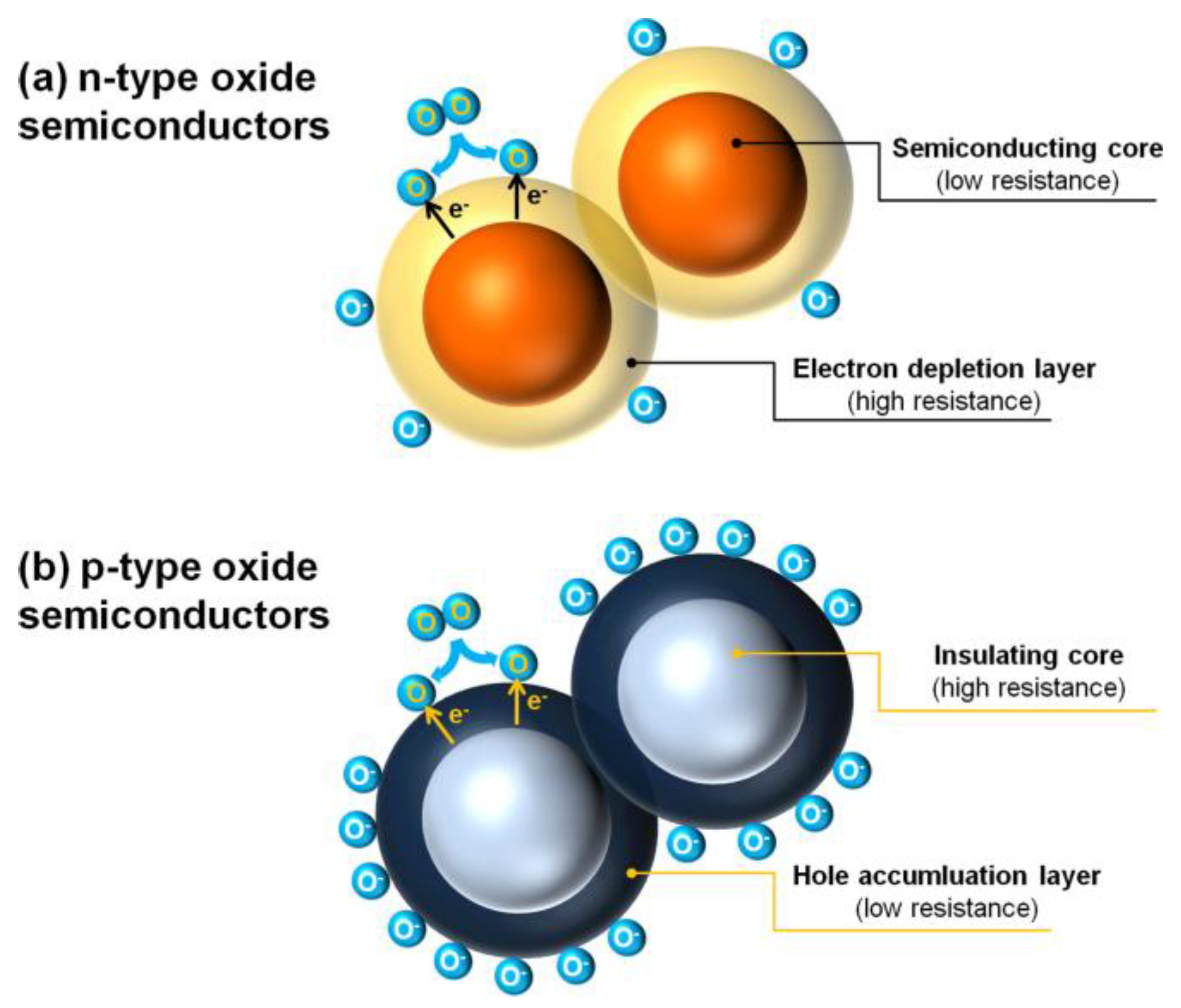
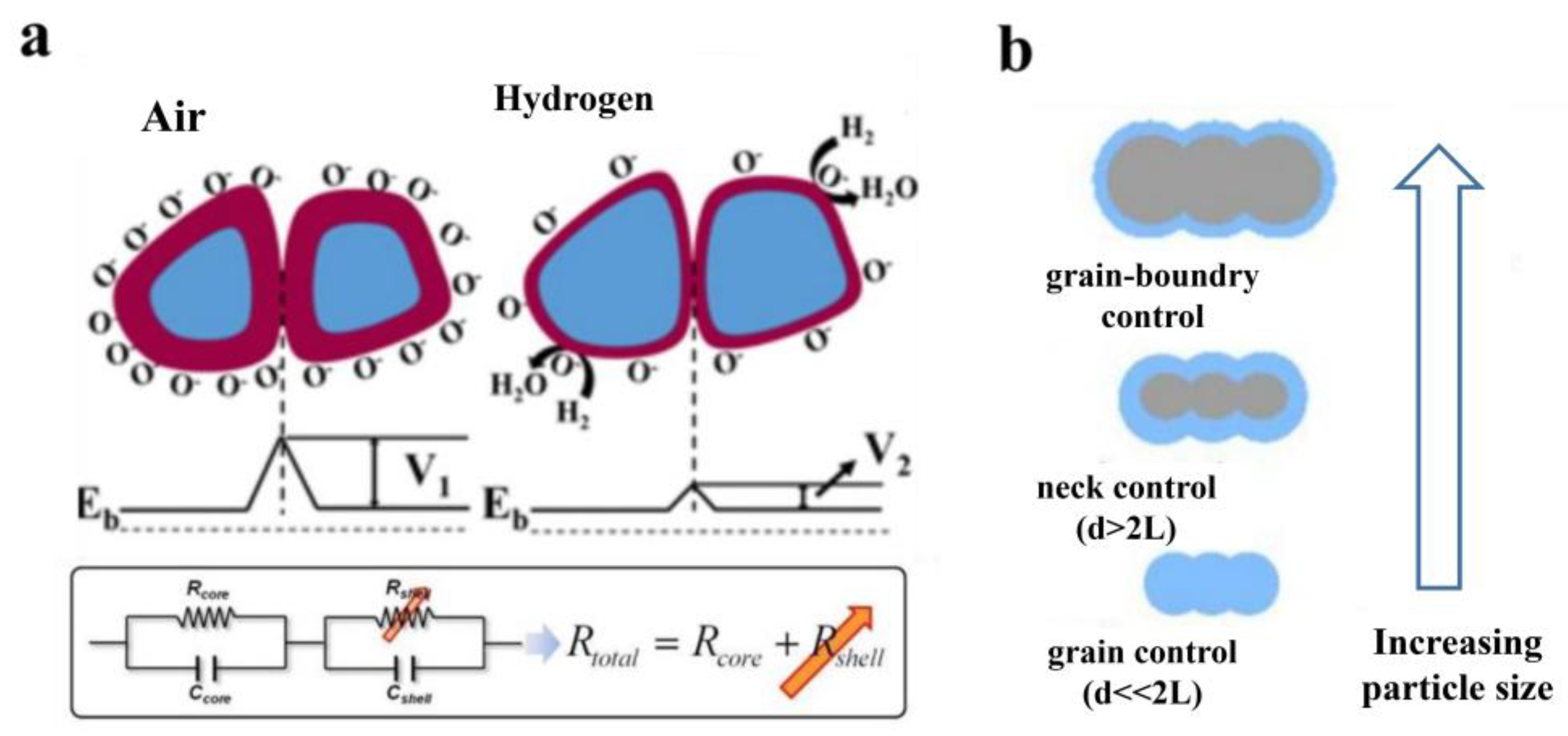
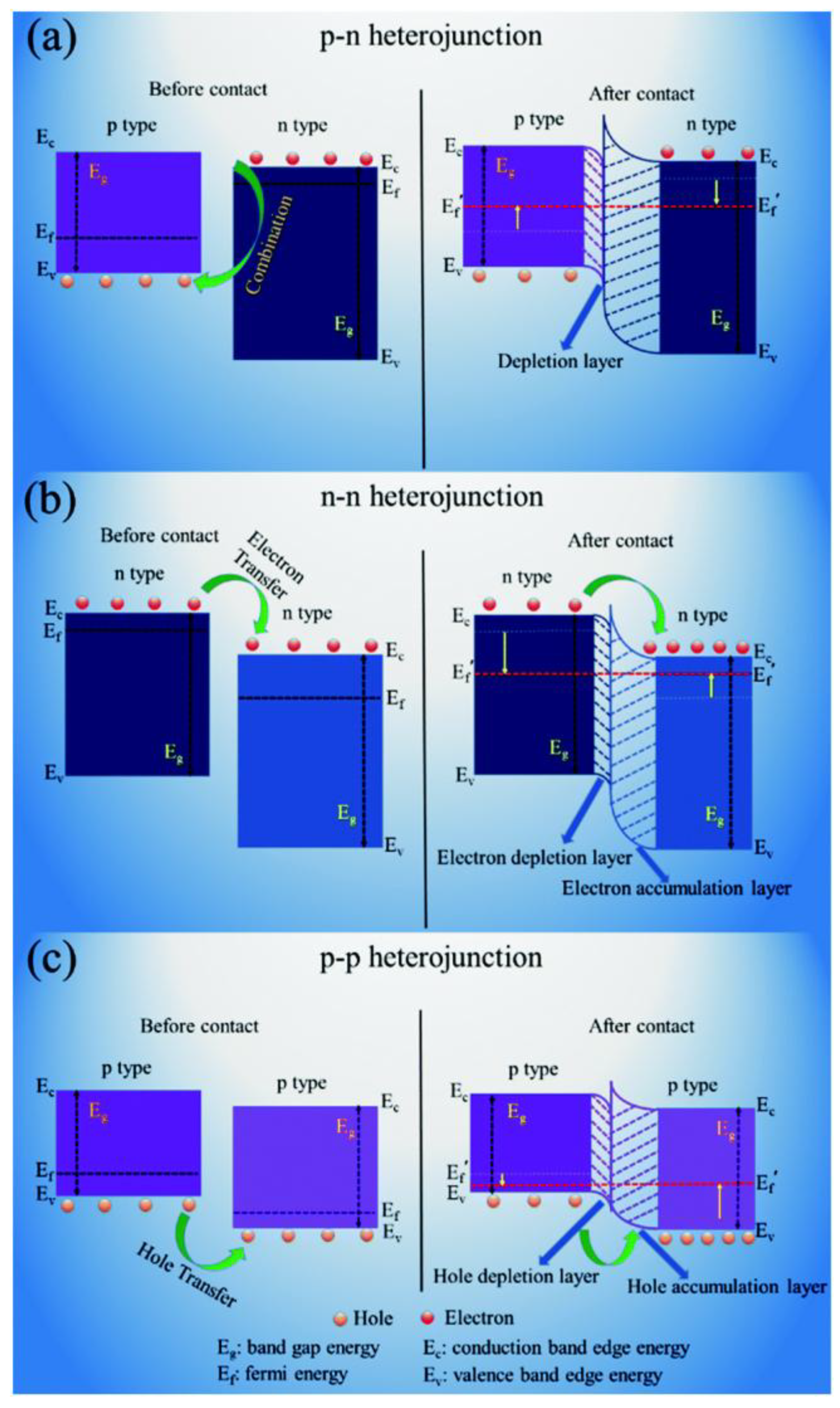

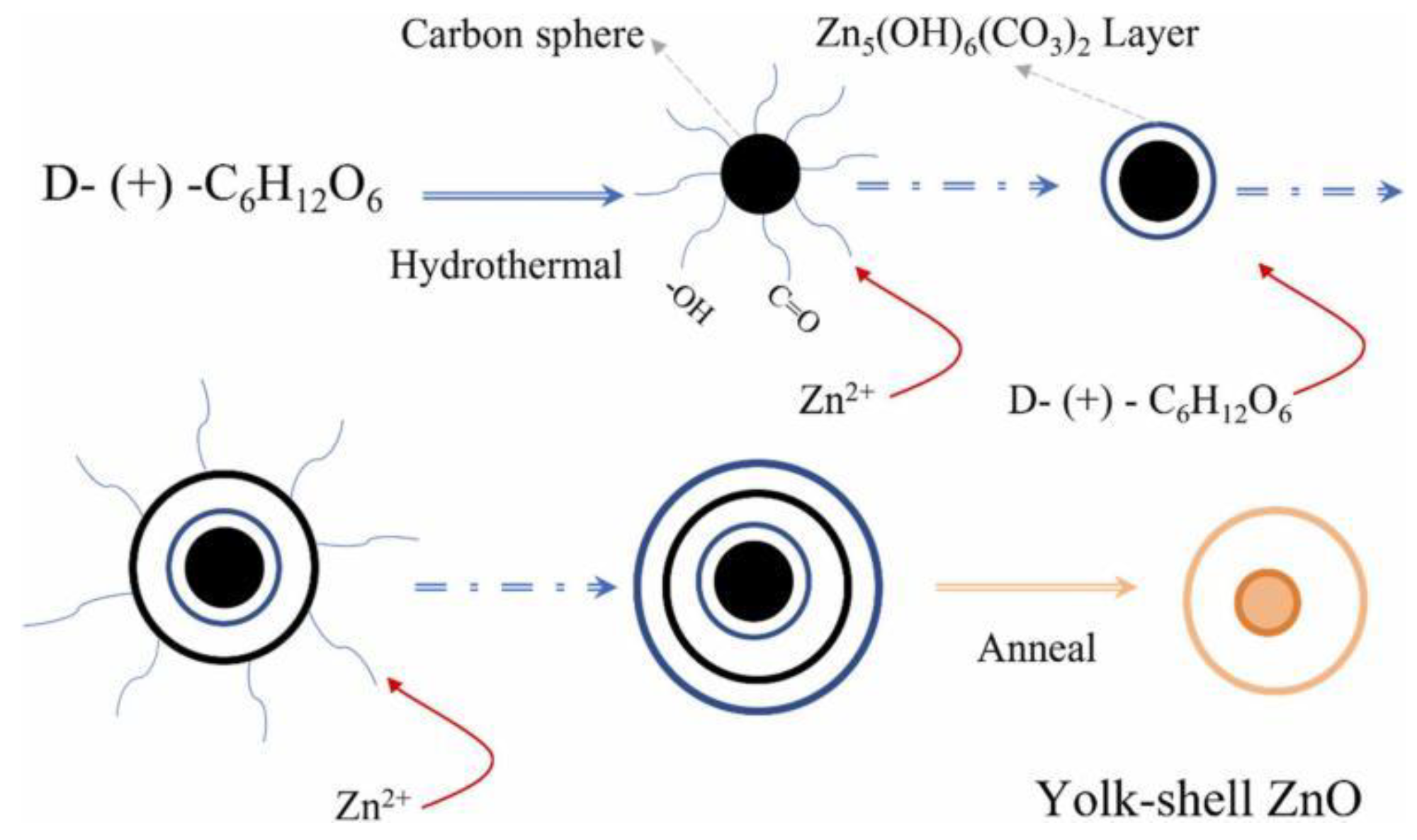
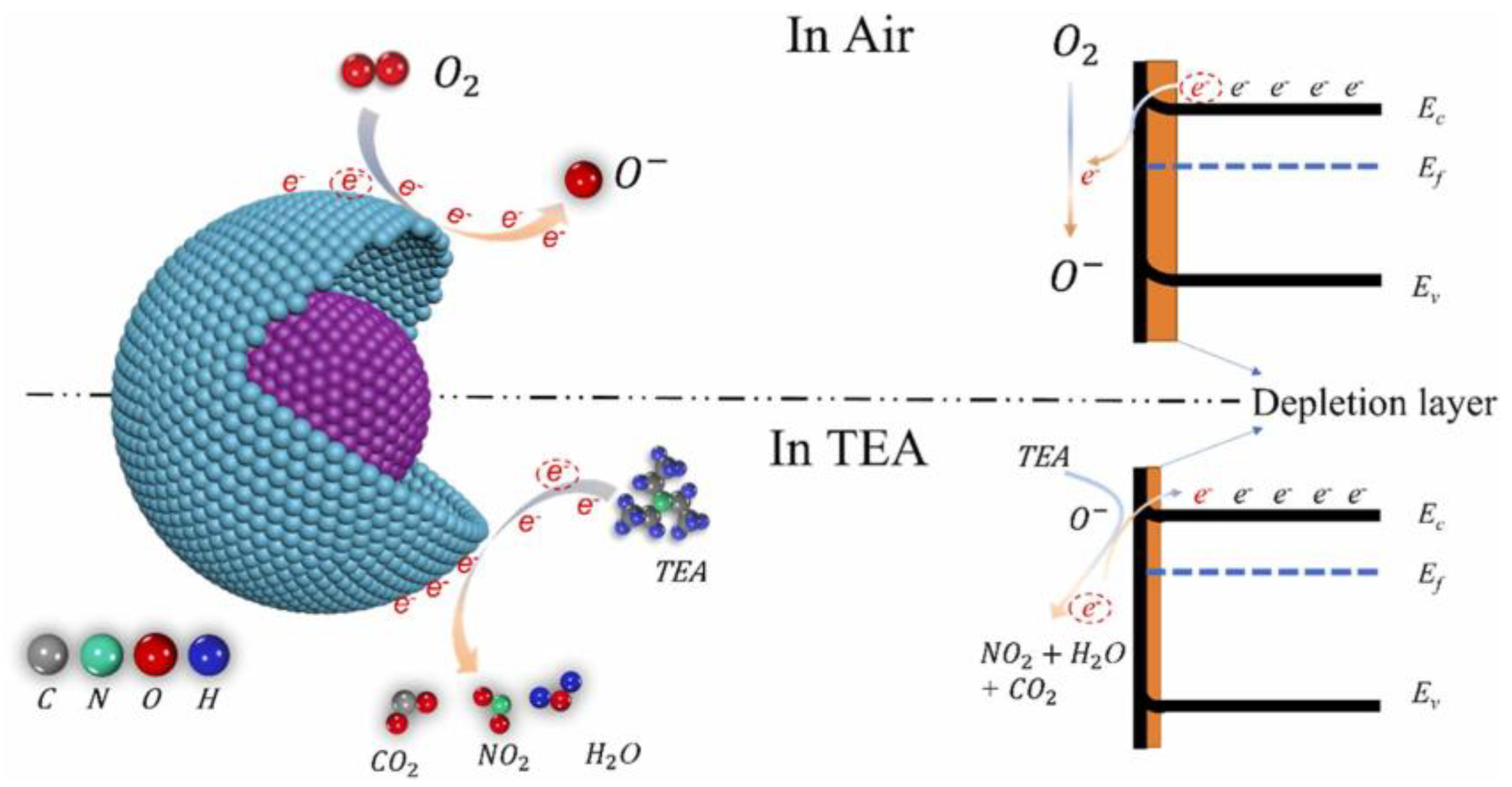

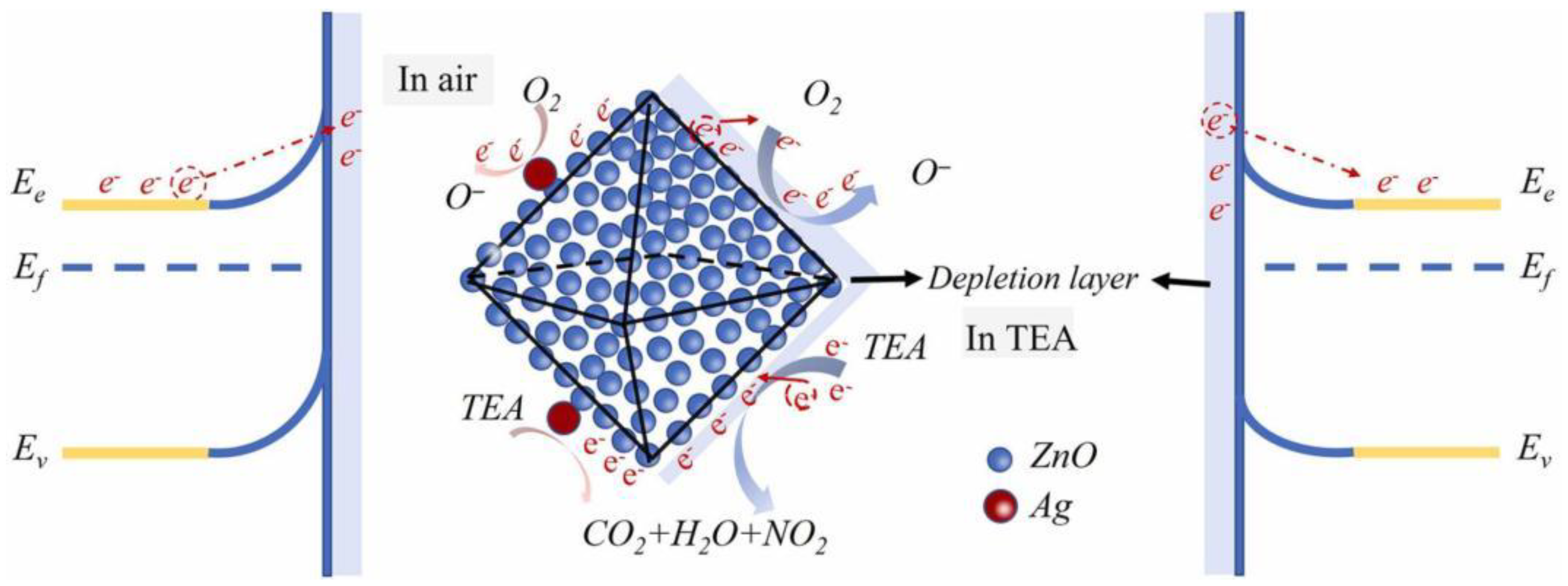
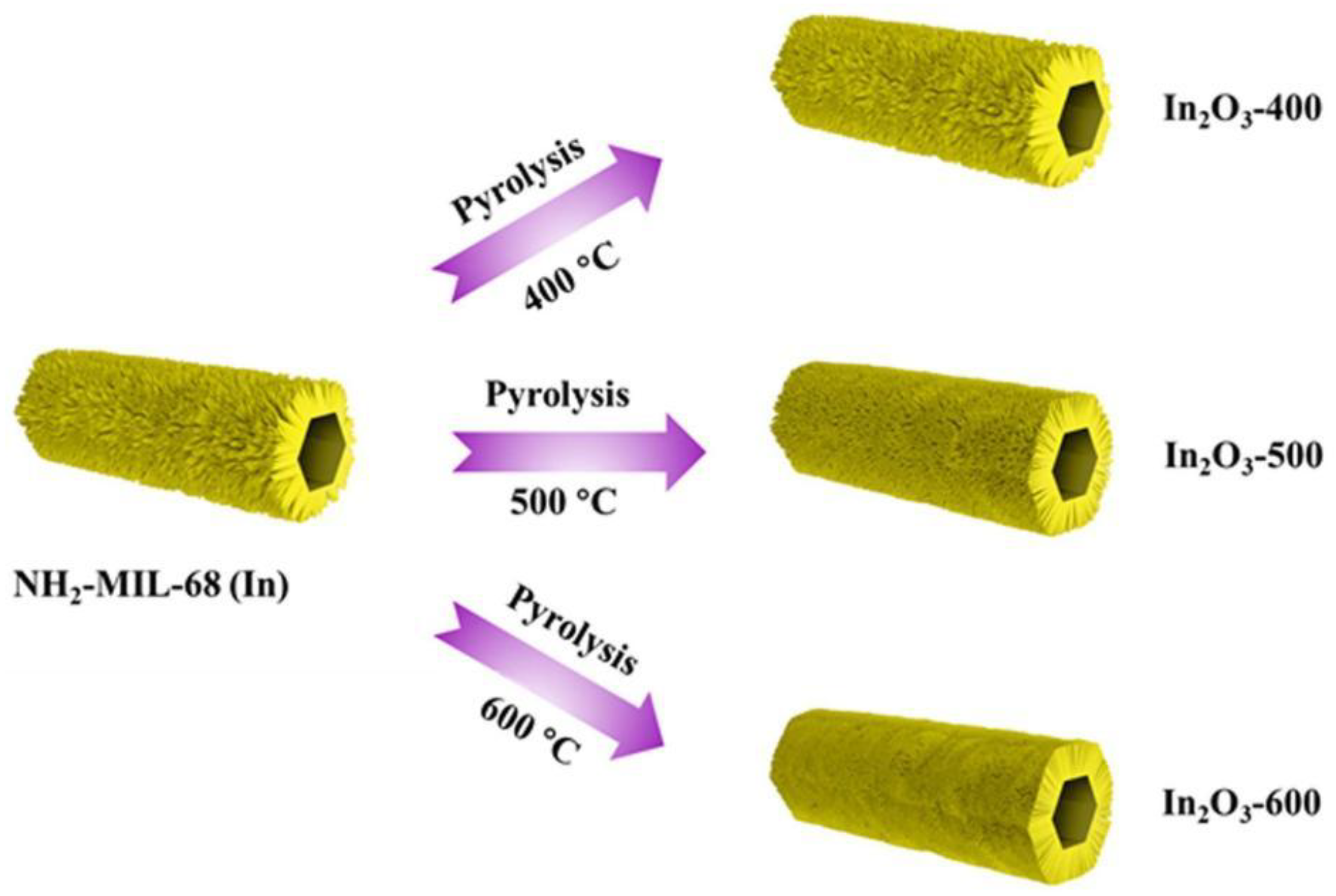
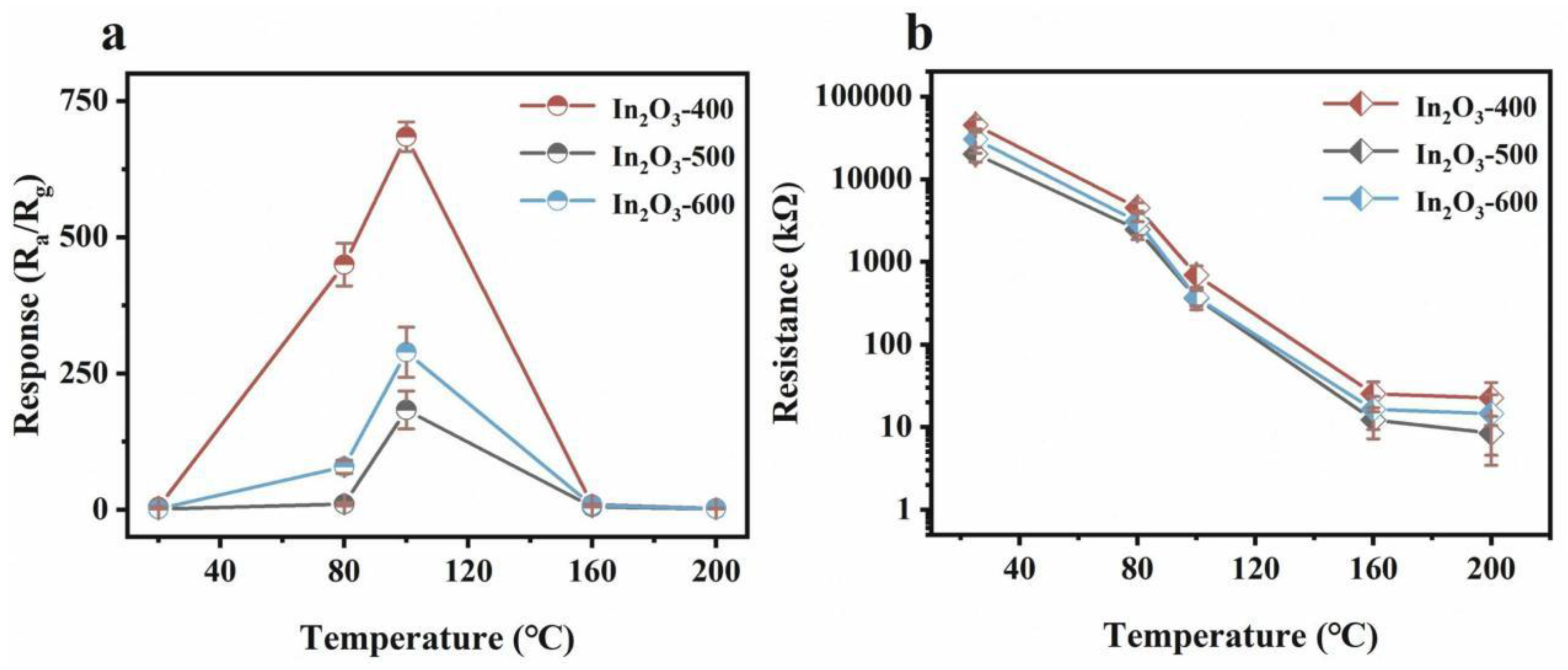
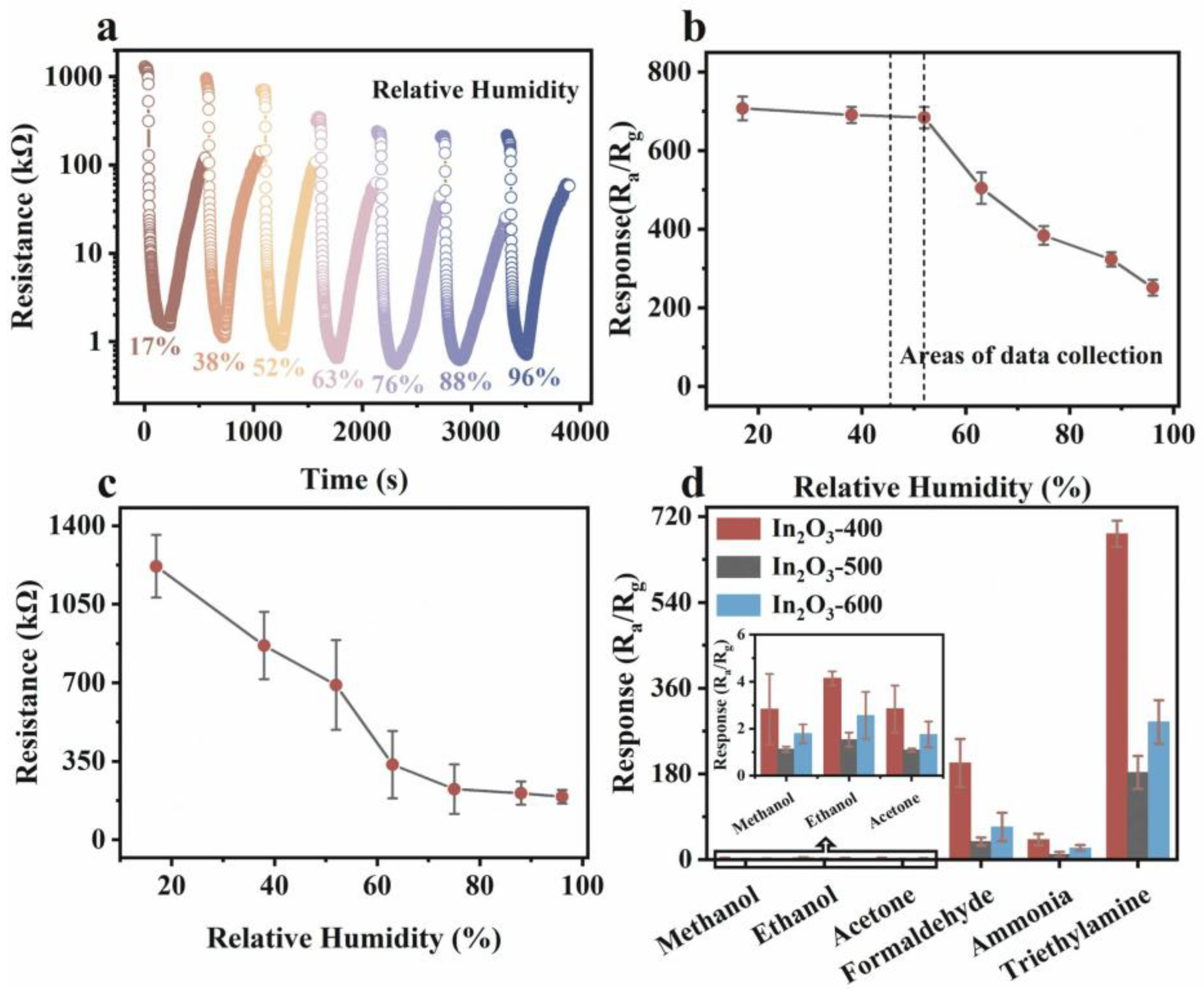
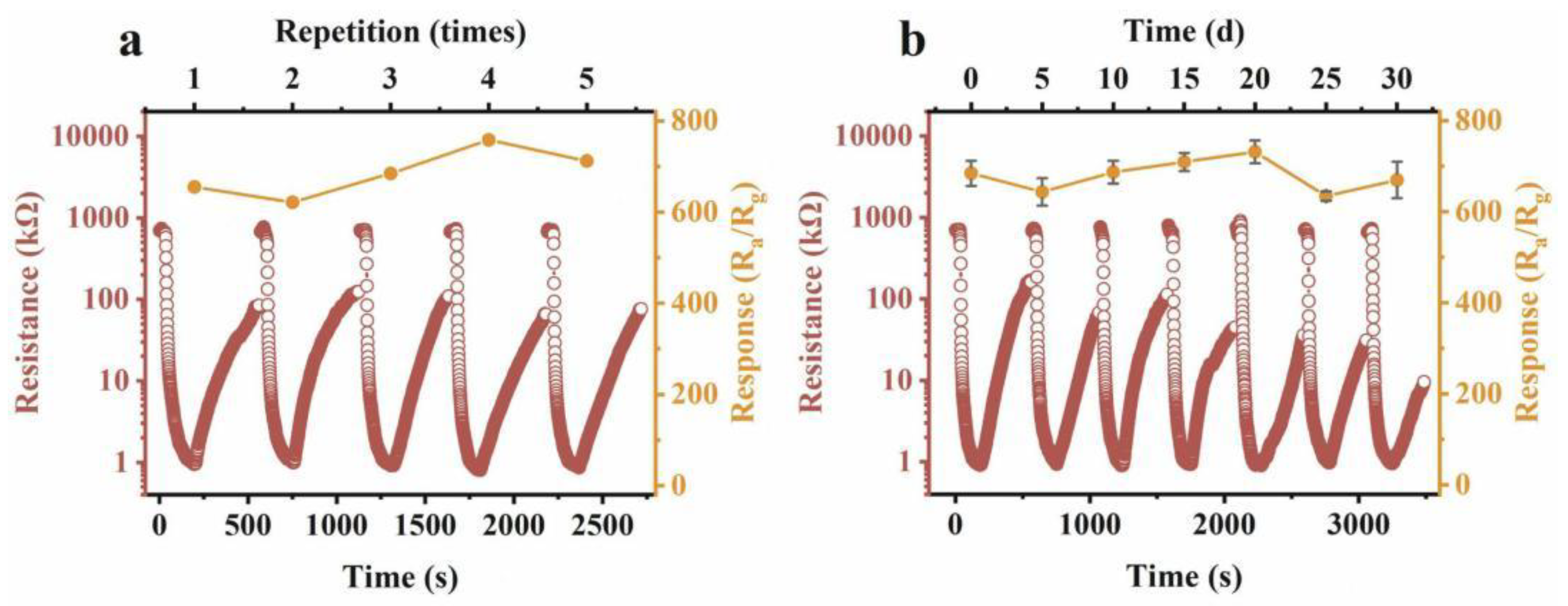


| Sensitive Materials | Operating Temperature (°C) | Concentration (ppm) | Response and Recovery Time (s) | Response Value | References |
|---|---|---|---|---|---|
| SnO2 | 350 | 1 | <10/<10 | 3 | [23] |
| NiO | 350 | 9 | 6–11/9–22 | 1.38 | [24] |
| NiO-ZnO | 320 | 100 | 7/33 | 300 | [25] |
| ZnO/ZnFe2O4 | 80 | 500 | About 100/- | 10 | [26] |
| Al doped ZnO/NiO | 250 | 200 | - | 35 | [27] |
| Co3O4/1n2O3 | 250 | 2 | 47/20 | 6.5 | [28] |
| SnO2/NiO | 70 | 10 | 86/95 | [29] |
| Material | Detection Gas | Concentration (ppm/ppb) | Best Operating Temperature (°C) |
|---|---|---|---|
| SnO2 | NO2 | 1 ppm | 250–300 °C |
| ZnO | Ethanol | 100 ppb | 300 °C |
| WO3 | O3 | 50 ppb | 200 °C |
| Fe2O3 | H2S | 10 ppm | 200 °C |
| In2O3 | NH3 | 500 ppb | 225 °C |
| TiO2 | CO | 5 ppm | 275 °C |
Disclaimer/Publisher’s Note: The statements, opinions and data contained in all publications are solely those of the individual author(s) and contributor(s) and not of MDPI and/or the editor(s). MDPI and/or the editor(s) disclaim responsibility for any injury to people or property resulting from any ideas, methods, instructions or products referred to in the content. |
© 2025 by the authors. Licensee MDPI, Basel, Switzerland. This article is an open access article distributed under the terms and conditions of the Creative Commons Attribution (CC BY) license (https://creativecommons.org/licenses/by/4.0/).
Share and Cite
Fan, Y.; Song, L.; Wang, W.; Fan, H. Nano-Micro Structure of Metal Oxide Semiconductors for Triethylamine Sensors: ZnO and In2O3. Nanomaterials 2025, 15, 427. https://doi.org/10.3390/nano15060427
Fan Y, Song L, Wang W, Fan H. Nano-Micro Structure of Metal Oxide Semiconductors for Triethylamine Sensors: ZnO and In2O3. Nanomaterials. 2025; 15(6):427. https://doi.org/10.3390/nano15060427
Chicago/Turabian StyleFan, Yongbo, Lixin Song, Weijia Wang, and Huiqing Fan. 2025. "Nano-Micro Structure of Metal Oxide Semiconductors for Triethylamine Sensors: ZnO and In2O3" Nanomaterials 15, no. 6: 427. https://doi.org/10.3390/nano15060427
APA StyleFan, Y., Song, L., Wang, W., & Fan, H. (2025). Nano-Micro Structure of Metal Oxide Semiconductors for Triethylamine Sensors: ZnO and In2O3. Nanomaterials, 15(6), 427. https://doi.org/10.3390/nano15060427







